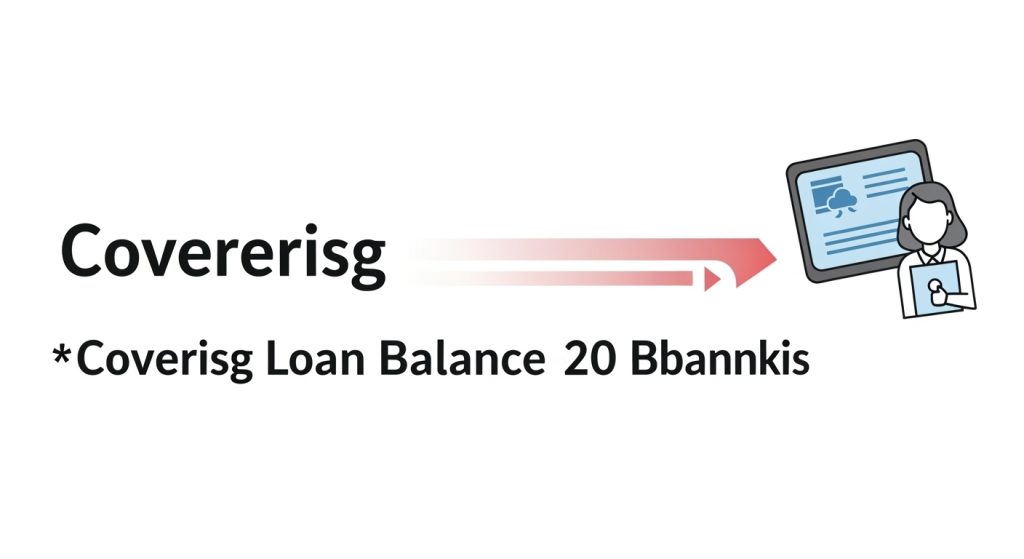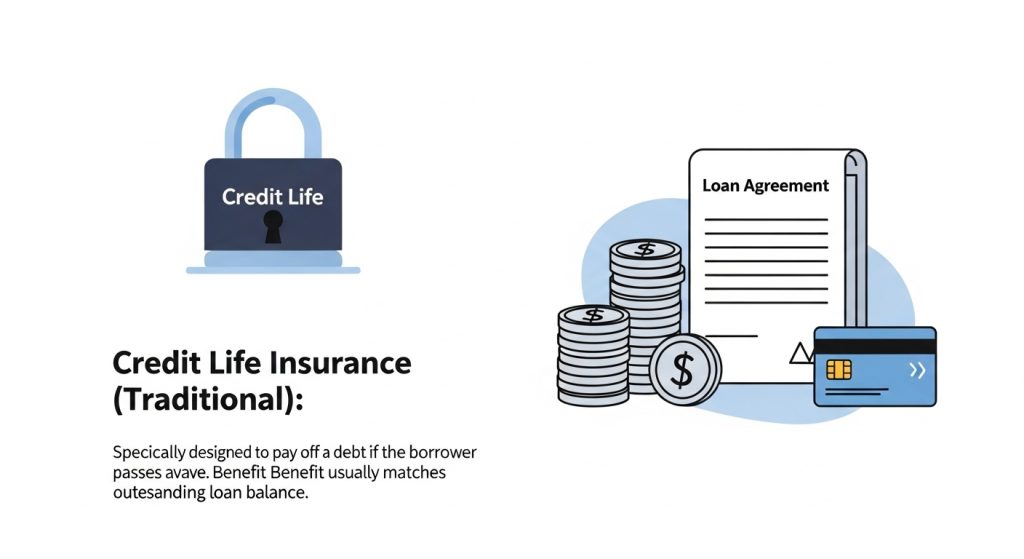Table of Contents
Life insurance plays a vital role in providing financial security, but not all policies serve the same purpose. One specific type often tied directly to loans or debts is credit life insurance.
Many borrowers ask: What type of life insurance are credit policies issued as? The short answer is that credit policies are typically issued as term life insurance, specifically a decreasing term policy designed to cover outstanding loan balances.
In this guide, we’ll break down exactly how credit life insurance works, who offers it, its benefits and drawbacks, and how it compares to other life insurance options. We’ll also explore when it makes sense to buy and when you may want to consider alternatives.
Why Credit Life Insurance Exists
The purpose of credit life insurance is simple: to protect lenders and borrowers by ensuring debts are paid if the borrower passes away before the loan is fully repaid. Instead of leaving a spouse or family with unpaid obligations, the policy pays off the balance.
- Protects lenders: Guarantees loan repayment, reducing financial risk.
- Relieves families: Prevents survivors from inheriting debt burdens.
- Commonly linked loans: Mortgages, auto loans, and even credit cards.
Example: Sarah financed a $20,000 car loan. She opted for credit life insurance at signing. When she unexpectedly passed away, the policy cleared her loan balance, protecting her family from added financial strain.
How Credit Life Insurance Works

Credit life insurance is almost always issued as decreasing term life insurance. That means coverage lasts for the duration of the loan and declines as the balance shrinks.
- Temporary coverage: The policy lasts only as long as the loan term (e.g., 5, 10, or 30 years).
- Decreasing benefit: The payout amount reduces in line with the declining loan balance.
- No cash value: Unlike whole life insurance, it doesn’t accumulate savings or investment value.
Example: John has a 15-year mortgage. His credit life insurance covers only the mortgage balance. Each year, as his loan balance drops, the policy’s coverage decreases proportionately.
Key Features of Credit Life Insurance Policies
Credit life insurance has unique features that set it apart from other types of life insurance.
- Tied to a specific debt: Only pays off the lender, not the borrower’s family.
- Simplified approval: No medical exam eligibility is tied to loan approval.
- Convenient enrollment: Offered at loan origination and added to paperwork.
- Automatic premiums: Often bundled into monthly loan payments.
Example: Maria took out a personal loan, and the bank offered credit life insurance. She didn’t need to undergo medical underwriting, making it quick and accessible.
Where to Get Credit Life Insurance
Credit life insurance is typically offered at the point of sale when you take out a loan.
- Banks and credit unions: Provide coverage directly during loan agreements.
- Lender-insurer partnerships: Lenders work with insurers such as MetLife, Genworth, or Prudential to underwrite policies.
- Auto dealers & mortgage lenders: Frequently package coverage into loan documents.
Example: Tom got a mortgage from his community bank. The bank partnered with a national insurer to offer credit life coverage seamlessly with his loan paperwork.
Credit Life vs. Other Types of Life Insurance

While credit life insurance is convenient, it differs significantly from other forms of life insurance.
| Insurance Type | Coverage Focus | Payout | Flexibility | Builds Cash Value |
|---|---|---|---|---|
| Credit Life Insurance | Pays off loan balance only | Lender | No | No |
| Term Life Insurance | Income replacement, debts, family needs | Beneficiaries | Yes | No |
| Whole Life Insurance | Lifelong coverage + savings | Beneficiaries | Yes | Yes |
| Universal Life Insurance | Flexible premiums & coverage | Beneficiaries | Yes | Yes |
Example: Lisa considered whole life insurance for long-term needs. But for her short-term auto loan, she chose credit life it was cheaper and solved a specific problem.
Cost of Credit Life Insurance
One of the most important considerations is cost. Credit life insurance is often more expensive per dollar of coverage compared to traditional term life insurance.
- Premiums are typically calculated as $0.25–$0.50 per $100 of monthly loan balance.
- Coverage shrinks as the loan decreases, but premiums may remain the same making it less cost-effective over time.
- For the same price, many borrowers could purchase a larger term life policy that covers more than just debt.
Benefits for Borrowers and Lenders
For Borrowers
- Peace of mind: Surviving family members aren’t burdened by loan payments.
- Ease of access: Approval is simple, even for those with health issues.
- Automatic protection: The lender is paid directly, reducing stress for survivors.
For Lenders
- Guaranteed repayment: Protects against losses if the borrower dies.
- Stronger loan portfolios: Lowers financial risk for banks and credit unions.
Potential Drawbacks of Credit Life Insurance
While it has benefits, there are several limitations borrowers should weigh carefully.
- Limited payout: Only covers the loan, not other family expenses.
- Higher cost: Often pricier than term life insurance for the same coverage.
- No flexibility: Can’t be transferred to cover other debts or financial needs.
- Declining value: Coverage decreases over time, but premiums may not.
Example: Emily realized that a $250,000 term life policy cost less than her credit life insurance premium, while providing broader coverage for her mortgage and family’s living expenses.
When Credit Life Insurance Makes Sense
Credit life insurance isn’t for everyone, but it can be valuable in specific situations:
- Large loans: Such as mortgages or auto loans where repayment would burden a family.
- No existing coverage: Borrowers who don’t already have life insurance.
- Health concerns: Individuals unable to qualify for traditional policies due to medical issues.
Example: James had pre-existing health conditions and was declined for term life insurance. Credit life insurance tied to his mortgage was the only accessible option.
Alternatives to Credit Life Insurance
Before enrolling, compare other financial protection strategies:
- Term life insurance: Affordable, customizable, and covers both debts and family needs.
- Group life insurance: Often available through employers at low cost.
- Personal savings & emergency funds: Flexible option for smaller debts.
Example: Rachel chose a 20-year term life policy instead of credit life. It covered her mortgage plus future education costs for her children.
Regulations and Consumer Protections

Credit life insurance is regulated differently depending on location:
- In the U.S., state insurance commissioners oversee credit life policies.
- Some states limit premiums to protect consumers from overpriced add-ons.
- Federal law requires clear disclosure when credit life insurance is optional, preventing lenders from pressuring borrowers.
This means borrowers should always read the fine print and confirm whether coverage is mandatory (rare) or optional.
How to Evaluate If You Need Credit Life Insurance
Ask yourself these key questions before signing up:
- Do you already have life insurance? If yes, it may cover your debts without needing a credit-specific policy.
- How large is your debt? Big loans like mortgages may justify extra protection.
- Can you qualify for a term policy? If you’re healthy, term life may be more affordable and flexible.
- What’s the cost per dollar of coverage? Compare credit life vs. traditional policies.
Example: David reviewed his finances and realized his existing $500,000 term life policy covered both his mortgage and family needs. He skipped credit life insurance to save money.
Final Thoughts
So, what type of life insurance are credit policies issued as? The answer is term life insurance, specifically in the form of credit life coverage tied to loan balances. While credit life insurance provides peace of mind by ensuring debts are repaid, it’s often more expensive and less flexible than traditional life insurance options.
Before enrolling, compare costs, consider alternatives like term life, and evaluate your family’s broader financial needs. In many cases, a well-structured life insurance policy provides greater value than a narrow credit life policy.
For more information, check resources such as the National Association of Insurance Commissioners (NAIC) or Investopedia’s Credit Life Insurance Guide.
FAQs
Is credit life insurance the same as term life insurance?
Not exactly. Credit life insurance is a specialized form of decreasing term life insurance tied to a loan. Traditional term life covers a broader range of financial needs.
Do I need credit life insurance if I already have life insurance?
Often no. If your existing life insurance policy covers your debts and provides for your family, credit life may be unnecessary.
Does credit life insurance cover disability or job loss?
No. It only covers death. For disability or unemployment, you’d need separate coverage.
Who receives the payout from credit life insurance?
The lender not your family receives the payout, which is applied directly to your loan balance.
Is credit life insurance mandatory?
No. In most countries, it’s optional. Regulations require lenders to disclose this clearly.

